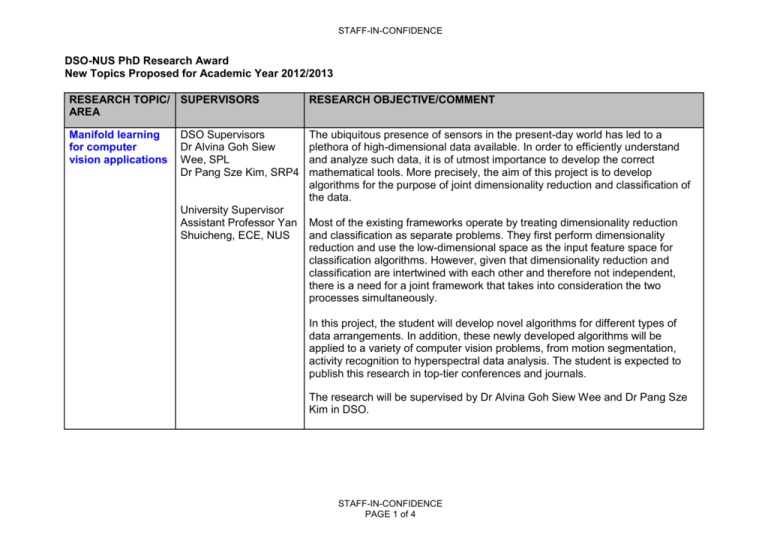Start typing here
advertisement

STAFF-IN-CONFIDENCE DSO-NUS PhD Research Award New Topics Proposed for Academic Year 2012/2013 RESEARCH TOPIC/ SUPERVISORS AREA RESEARCH OBJECTIVE/COMMENT Manifold learning for computer vision applications The ubiquitous presence of sensors in the present-day world has led to a plethora of high-dimensional data available. In order to efficiently understand and analyze such data, it is of utmost importance to develop the correct mathematical tools. More precisely, the aim of this project is to develop algorithms for the purpose of joint dimensionality reduction and classification of the data. DSO Supervisors Dr Alvina Goh Siew Wee, SPL Dr Pang Sze Kim, SRP4 University Supervisor Assistant Professor Yan Shuicheng, ECE, NUS Most of the existing frameworks operate by treating dimensionality reduction and classification as separate problems. They first perform dimensionality reduction and use the low-dimensional space as the input feature space for classification algorithms. However, given that dimensionality reduction and classification are intertwined with each other and therefore not independent, there is a need for a joint framework that takes into consideration the two processes simultaneously. In this project, the student will develop novel algorithms for different types of data arrangements. In addition, these newly developed algorithms will be applied to a variety of computer vision problems, from motion segmentation, activity recognition to hyperspectral data analysis. The student is expected to publish this research in top-tier conferences and journals. The research will be supervised by Dr Alvina Goh Siew Wee and Dr Pang Sze Kim in DSO. STAFF-IN-CONFIDENCE PAGE 1 of 4 STAFF-IN-CONFIDENCE RESEARCH TOPIC/AREA SUPERVISORS RESEARCH OBJECTIVE/COMMENT Physical Principles-based EM modelling DSO Supervisor Dr Chia Tse Tong The challenging task we are facing now for computational electromagnetics (CEM) is how to solve electromagnetic problems with practical configurations that are electrically large in size and complex in structure. These practical configurations normally consist of one very bigger main body or platform with some other smaller sub-structures that are removable or changeable. To efficiently model this kind of configurations, the whole structure of the problem to be solve is divided into smaller ones (i.e. sub-domains) and solve the subdomain problems to produce the solution of the whole domain problem, which is the main idea of domain decomposition methods (DDMs) developed and being developed. The restrictions of the DDMs include: University Supervisor Dr Wang Chao-Fu (TL@NUS) (1) Most DDMs are strongly dependent on the equations (IE or PDE with FEM) adopted for modelling problems. This cannot provide more flexibility to hybridize with other methods, such as other numerical techniques and high frequency techniques. (2) There is no way to combine solutions for sub-structures obtained using different techniques to produce a solution of the whole problem. (3) It is not easy to provide local modification of the configuration to be modelled for modelling removable and changeable substructures. To overcome the restrictions mentioned above, it is necessary to develop some physical principles to combine solution components obtained using different techniques according to the natural characteristic of the sub-structures of the configuration to be modelled. Some suggestions on this direction are: (1) To investigate equivalence principle algorithm for wave interaction with complex structures. STAFF-IN-CONFIDENCE PAGE 2 of 4 STAFF-IN-CONFIDENCE (2) To investigate how to realize modular algorithm for local modification for local design and modelling. (3) To investigate scattering diagrams in electromagnetic theory for combining solution components to produce a solution of the whole problem. Fast interpolation / DSO Supervisor extrapolation in EM Dr Chia Tse Tong University Supervisor Dr Wang Chao-Fu (TL@NUS) This research direction will focus on how to provide some possible ways to more efficiently produce useful EM response data with the wide range of frequency and/or angles based on the efficient EM solvers we have. To enhance the capability and flexibility of the reduced order modeling techniques (ROMT) to be developed, it is better to avoid following the normal fast frequency sweep techniques, such as AWE, as they cannot be applied to simulate large problems due to their need of performing matrix inverse. Some suggestions on this direction are: (1) To investigate smart interpolation/extrapolation algorithms for high frequency techniques. (2) To investigate smart interpolation/extrapolation algorithms to extract characteristic information from calculated or measured results (RCS or other EM response data) for reproducing useful data with more bandwidth. (3) To investigate a way to avoid performing matrix inverse or to perform matrix inverse in a smart and efficient way in normal fast sweep techniques with consideration for hybridization with fast algorithms. (4) To investigate other reduced order modelling techniques, such as POD based methods, for large EM problem modelling. (5) To investigate how to apply local approximation and global approximation techniques to EM problems with many unknowns. (6) To investigate how to develop efficient 2-D and 3-D sweep techniques using less sample points. STAFF-IN-CONFIDENCE PAGE 3 of 4 STAFF-IN-CONFIDENCE RESEARCH TOPIC/ SUPERVISORS AREA DMERI Fatigue/ Exercise Physiology DSO Supervisor Dr Jason Lee Kai Wei SMTS, CPP, DMERI University Supervisor Prof Soong Tuck Wah Department of Physiology / Yong Loo Lin School of Medicine RESEARCH OBJECTIVE/COMMENT The aetiology of fatigue appears to be complex and it is likely that several important factors are involved. Currently, physiological changes in peripheral mechanisms such as impaired substrate availability or utilization, accumulation of lactate, potassium and calcium distribution or the progressive loss of body fluids do not adequately explain the reduction in exercise performance; this leads to the suggestion that the central nervous system might be important as a causative factor in fatigue. The main aim of this research is to elucidate the underlying brain mechanisms to explain central fatigue and issues related to Mind over Body. The research design will mimic modern combat stresses (e.g. sleep disruption, energy deficit, environmental strain, information overload, psychological and physical exertion). These stressors will either be studied in isolation or in combination. Together with standard biomarkers and functional assessment (physical and cognitive tests), we will employ methods, such as the transcranial magnetic stimulation, EEG and other imaging techniques to link changes in cortical excitability to changes in cerebral carbohydrate, amino acid and neurotransmitter metabolism, as well as to metabolite and hormonal signalling between the brain and the muscles. Outcomes from this research will provide opportunities for targeted strategies (training, nutrition etc.) to be proposed to alleviate fatigue during intense military exercises. Furthermore, insights into mechanisms responsible for central fatigue/Mind over Body could be relevant for the treatment of soldiers suffering from diseases associated with chronic fatigue. STAFF-IN-CONFIDENCE PAGE 4 of 4






